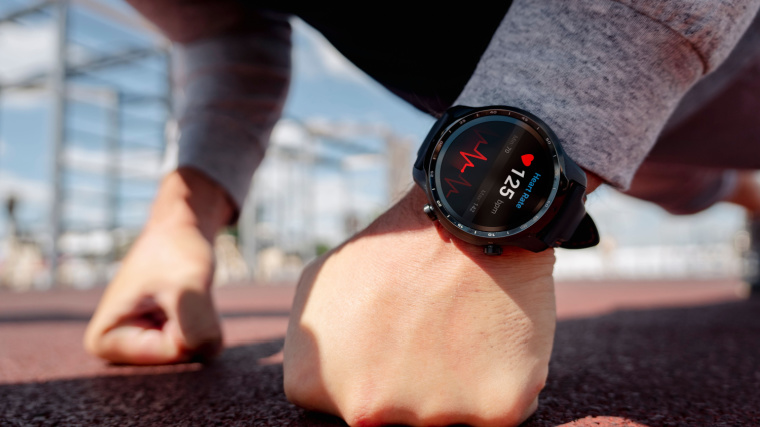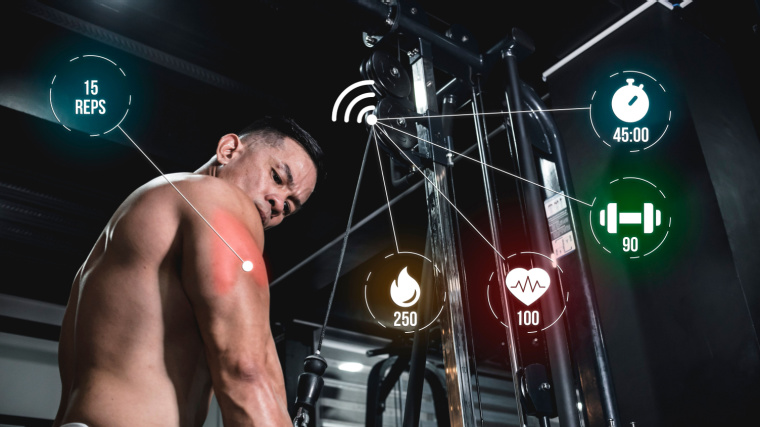If you’re aiming to create a caloric deficit to drive some fat loss, you may rely on cardiovascular training to give that deficit a boost. In your search for the most efficient cardio workouts to help you along, it can help to know exactly what’s going on with your heart during these bouts of exercise.

Your heartbeat is more than just a gauge of your exertion; it can be a clue as to how effectively engaged you are in burning body fat. Learning to fine-tune your activity level and keep your heart within an optimal beats-per-minute (BPM) range is an important skill. Fine-tuning this tool can help you more efficiently shed calories while tactically upgrading your overall fitness level.
- The Different Heart Rate Zones Explained
- More on the Fat-Burning Heart Rate Zone
- Different Ways to Measure Your Heart Rate
- Try This Fat-Burning Heart Rate Zone Workout
- The Difference Between Fat-Burning and Weight Loss
- Frequently Asked Questions
The Different Heart Rate Zones Explained
The general premise behind heart rate zones is that your body can burn different energy sources as fuel when your heart rate reaches and sustains a certain number of beats per minute.

[Read More: Best Macros Calculator for Tracking Muscle Gain and Fat Loss]
In essence, while high-intensity training might be preferable to prepare you for certain sports or activities, training at lower-intensity levels might help you burn calories more sustainably.
That said, just because you’re in a “fat-burning” zone with your heart rate does not mean you are automatically burning more calories overall or that you are guaranteed to lose a certain amount of body fat. This zone simply refers to one aspect of a very complex series of physiological processes. Finding the process that feels most sustainable for your body is key to healthy, long-term body recomposition.
Heart Rate Zone 1: Very Light, 50-60 Percent
The first heart rate zone corresponds to low-intensity exercise that raises your body just above its resting heart rate. This is often associated with leisurely activities like walking or the warm-up and cool-down phases of a training session.
If your heart rate is in Zone 1, you will probably feel like you could maintain your activity level for a nearly infinite length of time.
Heart Rate Zone 2: Light, 60-70 Percent
Zone 2 is where traditional aerobic activity begins, meaning that your body relies on a sustained uptick in your oxygen level to help you burn stored energy. (1) This stored energy will either be in the form of healthy carbs that have been stored as muscle glycogen or glucose, or unused calories in general, which are stored as body fat.
This effort level should be sustainable for long periods of time.
Heart Rate Zone 3: Moderate, 70-80 Percent
When it comes to fat-burning, Zone 3 is often considered the sweet spot. (2) This is because Zone 3 requires you to operate safely within the middle range of fat-burning territory, without pushing your workout into unsustainable territory.

[Read More: 5 At-Home Workouts for Strength, Muscle Growth, Power, and More]
This effort level will maximize your capacity to sustain aerobic exercise as you work hard to maintain a peak level of steady-state cardio.
Heart Rate Zone 4: Heavy, 80-90 Percent
If you’re training in Zone 4, you are typically testing the boundaries of your anaerobic activity, encompassing efforts you can maintain for anywhere from two to 10 minutes at a time. (1)
[Read More: What You Need to Know About How to Build Muscle]
Your effort level will be at a higher intensity. It will still be a step below sprinting, but you will still feel very challenged throughout your effort.
Heart Rate Zone 5: Maximum, 90-100 Percent
If you’re training in Zone 5, you’re delivering an all-out effort that is going to push you to achieve your max heart rate. This is where high-intensity interval training thrives, as your body burns a vast amount of calories in a short period of time.
[Read More: The Best Online Workout Programs For Coaching, Cardio, Value, And More]
However, your endurance falls rapidly as your heart rate increases, and you will be hard-pressed to preserve your peak output for upward of 15 seconds, let alone a full minute.
More on the Fat-Burning Heart Rate Zone
The American Heart Association (AHA) lays out two target heart rates for exercise. Here’s how it breaks down:
- 50 to 70 percent of your maximum heart rate = moderate-intensity exercise
- 70-85 percent of your maximum heart rate = vigorous physical activity
In essence, 85 percent has been listed as the peak desirable cardiovascular output for maintaining your heart health during prolonged exercise.
To determine your maximum heart rate, the AHA advises that you subtract your age from 220. From there, you can calculate the BPM that corresponds to each of the five heart rate zones to determine when your body has entered its ideal fat-burning zone.

[Read More: How to Count Macros for Weight Loss, Muscle Gain, and Maintenance]
Note: While implementing a fat-burning strategy that is dependent upon your heart rate can be an effective way to lose body fat, there are other viable strategies — that may be even more effective — you can implement.
Focusing your energies on resistance training can certainly effectuate fat loss, as can a fat-burning strategy structured around high-intensity interval training. (3)(4) Remember that if you’re trying to promote fat loss, a solid bet is to promote an overall caloric deficit. If it’s psychologically safe for you to do so, focus more on calories than specifically trying to target fat with your workout types. You’ll get similar “results,” and it might even happen faster.
Ultimately, you’ll want to focus on a type of physical activity you find enjoyable. That will lead to more sustainable gains, anyway, since you’re more likely to stick to a routine that you like than one that you don’t. If working out in a particular heart rate zone doesn’t excite you, play around with other fitness methods that you like better.
Different Ways to Measure Your Heart Rate
You may believe that you’ve achieved your target heart rate, but measurement is the only way to be absolutely certain that you’re training within the optimal heart rate zone for fat loss and cardio training. Fortunately, there are several ways to monitor your heart rate to ensure that you’ve actually reached your target heart rate zone.
Using Two Fingers On Your Hand
If you’re mathematically inclined, you can check your pulse rate at your wrist or neck. To get a decent estimate of your heart rate, count how many times your heart beats in 10 seconds and multiply the number by six, or count for 15 seconds and multiply by four. Either way, you’ll get a decent sense of your effort level without relying on technology.
Using Your Personal Heart Rate Monitor
If you’d prefer immediate feedback from moment to moment, you can wear a heart rate monitor during your workouts.

[Read More: The 16 Best Pre-Workout Supplements]
Whether you prefer a heart rate monitor with a chest strap, or you feel a wrist-worn monitor is accurate enough for your purposes, you’ll be able to gauge your exertion level with a quick glance.
Using Your Favorite Cardio Machine’s Pulse Gauge
If you’ve selected the appropriate treadmill, elliptical, or stair climber, your cardio-training device of choice might come equipped with a pulse gauge built directly into it. You may not always have access to such a machine or want to hold onto both hands, but if you can, you’ll be able to achieve your target heart rate while you train.
Using Your Heart-Rate-Monitoring Phone App
There are now several smartphone apps capable of using your phone’s built-in technology to measure your heart rate. Specifically, the camera on your smartphone can be used to detect changes in your blood volume beneath your skin’s surface. Whether or not you feel you can fully entrust the accuracy of your heart rate workout to a smartphone app is up to you.
Try This Fat-Burning Heart Rate Zone Workout
If you’re looking for a workout that will keep your body in the desired aerobic zone, this workout has you covered. No matter what bodyweight cardio exercise you opt to do, maintaining your heart rate within these boundaries will ensure that you’re getting precisely the fat-burning benefits you want from your training.
The Workout
You can apply this training style to a cardio routine built on jogging or running, swimming, skiing, rowing, or just about any other form of cardiovascular exercise. The key here is keeping your heart rate within the prescribed range. This particular workout will also help you get familiarized with the boundary between aerobic and anaerobic training.
- Warm-Up: 2 minutes of very light cardio at 50-60% of your max heart rate, followed by 3 minutes of light cardio at 60-70% of your max heart rate.
- Workout Part One: 30 minutes of moderate cardio 70-80% of your max heart rate.
- Workout Part Two: 5 minutes of moderate-to-heavy cardio at 80-85% of your max heart rate.
- Workout Part Three: 15 minutes of moderate cardio at 70-80% of your max heart rate.
- Cool-Down: 5 minutes of very light cardio to return your heart rate to 50-60% of its max.
The Difference Between Fat-Burning and Weight Loss
Your body weight can fluctuate based on a number of factors, from how much food you’ve eaten to your hydration level, and quite frankly to whether or not you’ve recently gone to the bathroom. While sustained cardiovascular activity can cause fluid loss due to sweating, that water weight is replenished as soon as you rehydrate your body.
Fat-burning requires you to eliminate calories that have been stored as body fat, whether the food sources behind those calories originally consisted of fats, carbohydrates, or proteins. To stimulate this process through exercise, you’ll need to routinely place your body in circumstances where it is entering a stable fat-burning state.

[Read More: The Best BMR Calculator for Fat Loss and Muscle Gain]
Resistance training with an aim at inducting for muscle hypertrophy — otherwise known as muscle growth — has been shown to promote the breakdown of fatty tissue. (3) Similarly, high-intensity interval training has been shown to be at least as effective at burning fat as moderate-intensity exercise, while requiring significantly less time. (4)
Of course, calories are calories: even if you’re not in a “fat-burning zone,” using more energy than you’re taking in can stimulate fat loss.
Jumpstart Your Heart
High-intensity exercise might leave you feeling extra breathless and sweaty, but lower-impact, low-intensity steady-state cardiovascular training (LISS cardio) is still a ticket to the steady shedding of body fat. Moreover, it’s a proven method for lowering blood pressure and warding off cardiovascular disease. Where healthcare is concerned, this is simply a case of slow and steady doing well in the race.
FAQs
If you’re hoping that tracking your heart rate can help you shed body fat, we have answers to some of your key questions right here.
The fat-burning heart rate zone is typically cited as being between 70 to 80 percent of your maximum heart rate. To find this zone, subtract your age from 220, and then multiply that number by 0.7 and 0.8 to determine the boundaries of your personal fat-burning heart rate zone.
The number of calories burned within the fat-burning heart rate zone varies based on considerations of gender, age, and body weight. No one-size-fits-all formula applies. However, for the sake of offering an example, a 30-year-old, 175-pound man could expect to burn 791 calories by running for one hour at 140 BPM, according to at least one measurement tool.
References
- Patel H, Alkhawam H, Madanieh R, Shah N, Kosmas CE, Vittorio TJ. Aerobic vs anaerobic exercise training effects on the cardiovascular system. World J Cardiol. 2017 Feb 26;9(2):134-138.
- Carey DG. Quantifying differences in the “fat burning” zone and the aerobic zone: implications for training. J Strength Cond Res. 2009 Oct;23(7):2090-5.
- Vechetti IJ Jr, Peck BD, Wen Y, Walton RG, Valentino TR, Alimov AP, Dungan CM, Van Pelt DW, von Walden F, Alkner B, Peterson CA, McCarthy JJ. Mechanical overload-induced muscle-derived extracellular vesicles promote adipose tissue lipolysis. FASEB J. 2021 Jun;35(6):e21644.
- Wewege M, van den Berg R, Ward RE, Keech A. The effects of high-intensity interval training vs. moderate-intensity continuous training on body composition in overweight and obese adults: a systematic review and meta-analysis. Obes Rev. 2017 Jun;18(6):635-646.
Featured Image: VisualProduction / Shutterstock
The post Demystifying Your Fat-Burning Heart Rate Zone appeared first on BarBend.
